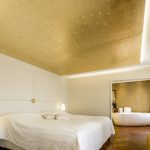The straight line is an inspired
invention of humankind’s.
That is why the serpent in the
Garden of Eden tempted Adam
and Eve not with an apple, but
with a ruler.
The architects of the Bauhaus are both brave and fearful, and that dichotomy is related to time. Time, claim some quantum physicists, does not exist. They see time as a human construct created to understand how events are connected and unfold. In truth, so the argument goes, everything – future and past – exists simultaneously, in parallel. What does that mean? An infinite present? An interesting thought, and one so revolutionary that not even the physicists themselves can make sense of it.
Who would come up with such a concept? Who did? At another, much more trivial level, everything is constructed: from egg cup to coffee-maker and soup spoon, everything is designed. Towns, landscapes, hairstyles, even the noise of a car door slamming are all compositions. The purr of an engine is not the same in Asia as it is in Europe, and Coca Cola, Sprite and Big Macs taste differently from country to country. There is no product whose ideal combination of function and attractive form has not been someone’s particular headache. And many of these designs are inspired by nature. We have cars that look like beetles, railings styled like vines, and snail-shaped confectionery.
Only one thing is almost entirely absent from nature: the straight line. The greatest designer of almost everything did not need the shortest line between two points, as everything exists in parallel and is somehow intertwined. The straight line is an inspired invention of humankind’s. That is why the serpent in the Garden of Eden tempted Adam and Eve not with an apple, but with a ruler. The Son of God was nailed to a cross made of straight pieces of wood, and the stake on the pyres on which the Inquisition burned its victims was also straight. The straight line is heretical. Perhaps that is why Bauhaus architecture still provokes and confuses abstract art to such an extent with its strict concentration on lines and geometric shapes? Straight lines create clarity, either symmetry or asymmetry; they rule out ambiguity. Where untamed nature is wild and threatening, straight lines offer security. Barricade tape, boundary marks, streets – humans break the world down to a size they can manage.
Straight lines are assertions, supports, that are hard to challenge. Even time as we imagine it is a straight line. Yet apparently it does not exist at all, or at least not as our limited imaginations would have it.
Straight lines offer security, create places of refuge in a chaotic and incomprehensible world beyond our control. So perhaps Bauhaus architects are fearful people who want to distance themselves from abundant and threatening nature with clear lines, and create certainty and security. At the same time, they are also brave, for there is also something heretical, subversive and unnatural about their clean shapes. But if it is true that time does not exist, then those shapes have always been there. Long live the straight line.

Franzobel is an Austrian writer. He has published numerous plays, works of prose and poems. His plays have been produced in countries including Mexico, Argentina, Chile, Denmark, France, Poland, Romania, Ukraine, Italy, Russia and the USA.
His great historical adventure novel “Das Floß der Medusa” (Zsolnay publishing house) was awarded the Bayerischer Buchpreis (Bavarian Book Award) 2017 and was on the shortlist for the German Book Prize 2017.






